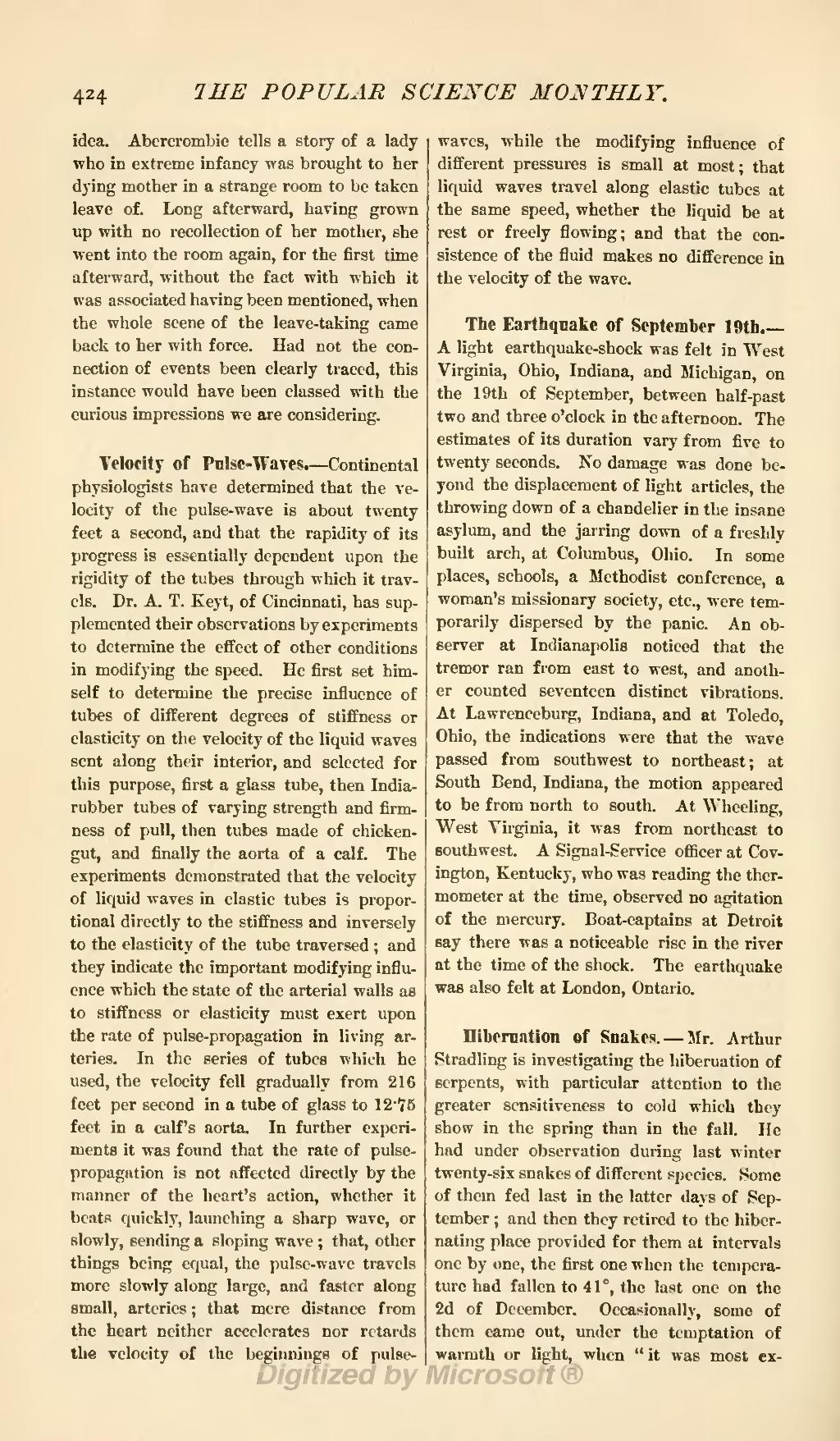idea. Abercrombie tells a story of a lady who in extreme infancy was brought to her dying mother in a strange room to be taken leave of. Long afterward, having grown up with no recollection of her mother, she went into the room again, for the first time afterward, without the fact with which it was associated having been mentioned, when the whole scene of the leave-taking came back to her with force. Had not the connection of events been clearly traced, this instance would have been classed with the curious impressions we are considering.
Velocity of Pulse-Waves.—Continental physiologists have determined that the velocity of the pulse-wave is about twenty feet a second, and that the rapidity of its progress is essentially dependent upon the rigidity of the tubes through which it travels. Dr. A. T. Keyt, of Cincinnati, has supplemented their observations by experiments to determine the effect of other conditions in modifying the speed. He first set himself to determine the precise influence of tubes of different degrees of stiffness or elasticity on the velocity of the liquid waves sent along their interior, and selected for this purpose, first a glass tube, then India rubber tubes of varying strength and firmness of pull, then tubes made of chicken gut, and finally the aorta of a calf. The experiments demonstrated that the velocity of liquid waves in elastic tubes is proportional directly to the stiffness and inversely to the elasticity of the tube traversed; and they indicate the important modifying influence which the state of the arterial walls as to stiffness or elasticity must exert upon the rate of pulse-propagation in living arteries. In the series of tubes which he used, the velocity fell gradually from 216 feet per second in a tube of glass to 12·75 feet in a calf's aorta. In further experiments it was found that the rate of pulse propagation is not affected directly by the manner of the heart's action, whether it beats quickly, launching a sharp wave, or slowly, sending a sloping wave; that, other things being equal, the pulse-wave travels more slowly along large, and faster along small, arteries; that mere distance from the heart neither accelerates nor retards the velocity of the beginnings of pulse waves, while the modifying influence of different pressures is small at most; that liquid waves travel along elastic tubes at the same speed, whether the liquid be at rest or freely flowing; and that the consistence of the fluid makes no difference in the velocity of the wave.
The Earthquake of September 19th.—A light earthquake-shock was felt in West Virginia, Ohio, Indiana, and Michigan, on the 19th of September, between half-past two and three o'clock in the afternoon. The estimates of its duration vary from five to twenty seconds. No damage was done beyond the displacement of light articles, the throwing down of a chandelier in the insane asylum, and the jarring down of a freshly built arch, at Columbus, Ohio. In some places, schools, a Methodist conference, a woman's missionary society, etc., were temporarily dispersed by the panic. An observer at Indianapolis noticed that the tremor ran from east to west, and another counted seventeen distinct vibrations. At Lawrenceburg, Indiana, and at Toledo, Ohio, the indications were that the wave passed from southwest to northeast; at South Bend, Indiana, the motion appeared to be from north to south. At Wheeling, West Virginia, it was from northeast to southwest. A Signal-Service officer at Covington, Kentucky, who was reading the thermometer at the time, observed no agitation of the mercury. Boat-captains at Detroit say there was a noticeable rise in the river at the time of the shock. The earthquake was also felt at London, Ontario.
Hibernation of Snakes.—Mr. Arthur Stradling is investigating the hibernation of serpents, with particular attention to the greater sensitiveness to cold which they show in the spring than in the fall. He had under observation during last winter twenty-six snakes of different species. Some of them fed last in the latter days of September; and then they retired to the hibernating place provided for them at intervals one by one, the first one when the temperature had fallen to 41°, the last one on the 2d of December. Occasionally, some of them came out, under the temptation of warmth or light, when "it was most ex-

